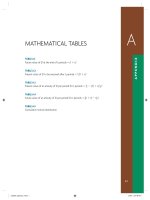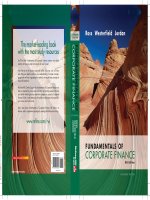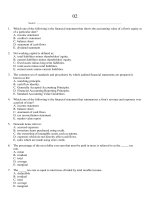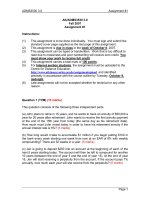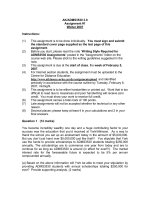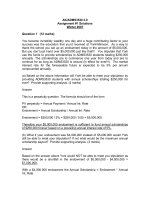final 2 fundamentals of corporate finance, 4th edition brealey
Bạn đang xem bản rút gọn của tài liệu. Xem và tải ngay bản đầy đủ của tài liệu tại đây (76.08 KB, 18 trang )
Name
Section
ID #
Professor Alagurajah’s Section A (Fridays, 2.30-5.30 pm), Professor King’s Section G
(Internet), Professor Kohen’s Section F (Tuesdays, 2:30-5:30 pm), Professor Li’s
Section E (Wednesdays, 2:30-5:30 pm), Professor Okonkwo’s Section B (Tuesdays, 710 pm), Professor Patterson’s Section D (Thursdays, 4-7 pm), and Professor Tahani’s
Section C (Wednesdays, 7-10 pm).
AP/ADMS 3530.03 Finance
Final Exam
Fall 2009
December 16, 2009
Exam - Solution
This exam consists of 50 multiple choice questions. 2 points each for a total of 100
points. Choose the response which best answers each question. Circle your answers
below, and fill in your answers on the bubble sheet. Only the bubble sheet is used to
determine your exam score. BE SURE TO BLACKEN THE BUBBLES
CORRESPONDING TO YOUR STUDENT NUMBER.
Please note the following eight points:
1) Please use your time efficiently and start with the questions that you are most
comfortable with first. Remember: every question carries the same weight, so
please do NOT spend too much time on one particular question;
2) Read the exam questions carefully;
3) Choose the answers that are closest to yours, because of possible rounding;
4) Keep at least 2 decimal places in your calculations and final answers, and at least
4 decimal places for interest rates;
5) Interest rates are annual unless otherwise stated;
6) Bonds pay semi-annual coupons unless otherwise stated;
7) Bonds have a par value (or face value) of $1,000;
8) Assume cash flows or payments occur at the end of a period or year, unless
otherwise stated; and
9) You may use the back of the exam paper as your scrap paper.
10) Non-programmable financial and/or scientific calculators are allowed.
Page 1
TYPE A
1
2
3
4
5
6
7
8
9
10
11
12
13
14
15
16
17
18
19
20
21
22
23
24
25
26
27
28
29
30
31
32
33
34
35
36
37
38
39
40
41
42
43
44
45
46
47
48
49
50
TYPE A Answer Keys
D
B
E
A
C
D
E
D
B
E
D
A
B
D
B
B
D
B
C
A
D
C
E
A
E
A
C
B
B
C
B
C
C
C
D
D
E
B
E
B
D
C
D
B
E
E
C
D
C
B
TYPE B
1
2
3
4
5
6
7
8
9
10
11
12
13
14
15
16
17
18
19
20
21
22
23
24
25
26
27
28
29
30
31
32
33
34
35
36
37
38
39
40
41
42
43
44
45
46
47
48
49
50
TYPE B Answer Keys
A
C
D
D
B
E
E
D
A
E
D
B
D
B
C
A
B
D
B
B
E
A
C
B
D
C
E
A
B
C
B
C
E
B
D
C
D
B
E
E
C
D
C
B
C
C
D
D
E
B
Corresponding in A
4
5
6
1
2
3
10
11
12
7
8
9
17
18
19
20
13
14
15
16
25
26
27
28
21
22
23
24
31
32
29
30
39
40
41
42
43
44
45
46
47
48
49
50
33
34
35
36
37
38
Numerical Questions
1. You have agreed to pay $1,500 per month on a one-year loan with a principal of
$16,300. What is the EAR of this loan?
A) 9.09%
B) 16.80%
C) 18.72%
D) 20.42%
E) 22.82%
Solution D
Using your calculator:
PMT = 1500, n=12, PV = -16,300, FV = 0, COMP I/Y Æ Im = .015603
EAR = (1.015603)12-1 = 20.4165%
2. You are planning to buy a $320,000 home with a 20% deposit. You finance the
remainder with a 25 year mortgage that has a stated rate of 5.40% (APR
compounded semi-annually). What is your monthly payment?
A) $1,470.49
B) $1,547.70
C) $1,738.78
D) $1,946.24
E) $2,145.87
Solution B
is = 5.40%/2 = 2.70%
EAR = (1+.0270) 2 -1 = 5.4729%
im = (1+0.054729)1/12 - 1 = 0.004450 = 0.4450%
n = 25 years x 12 = 300
Monthly Payment using your calculator:
n=300, I/Y=0.4450%, PV= -$256,000, FV=0, COMP PMT
PMT=$1,547.70
3. A 10-year bond was issued four years ago with a coupon rate of 5% and a face
value of $1,000. The coupons are paid semi-annually. What is the yield to maturity if
the bond is selling at $876.00 today?
A) 3.81%
B) 4.37%
C) 4.60%
D) 6.72%
E) 7.61%
Solution E
Page 2
Time remaining = 10 – 4 = 6 years = 12 semi-annual periods
FV= $1000
PMT = 5% x 1000/2 = $25.
PV= -$876.
Comp I/Y Æ I/Y = 3.8065
YTM = 3.8065 x2 = 7.6129%
4. How much would an investor lose if she purchased a 20-year zero-coupon bond with
a $1,000 par value and 4% yield to maturity, then sold it one year later when market
interest rates increased to 6%?
A) $125.88
B) $144.58
C) $155.98
D) $167.70
E) $170.51
Solution A
The bond was purchased for $1,000/(1+.04)20 = $456.39
The 19-year bond is worth $1,000/(1+.06)19 = $330.51
This is a decline of $125.88
5. A stock that will pay a $5 dividend next year sells today for $80. If the stock’s
required return is 14%, what should investors expect to pay for the stock one year
from now?
A) $80.00
B) $84.30
C) $86.20
D) $91.20
E) $95.59
Solution C
r = Div1/P0 + (P1 – P0)/P0
14% = $5/80 + (P1 - 80)/80
Î P1 = $86.20
6. Lacey Inc.’s common stock is expected to have extraordinary growth of 20% per
year for two years, after which time the growth will settle into a constant 5% rate. If
the discount rate is 11% and the most recent dividend was $1.50, what should be
the current share price?
A) $21.27
B) $22.20
C) $30.68
D) $34.05
Page 3
E) $37.80
Solution D
DIV1 = $1.50 x (1.20) = $1.80
DIV2 = $1.80 x (1.20) = $2.16
DIV3 = $2.16 x (1.05) = $2.268
P2= $2.268/ (.11-.05) = $37.80
P0= 1.80/(1.11) + 2.16/(1.11)2 + 37.80/(1.11)2
= 1.6216 + 1.7531 + 30.6793 = $34.0541
7. What is the minimum number of years that an investment costing $400,000 must
return $48,000 per year at a discount rate of 12 percent in order to be an acceptable
investment?
A) 4.29 years
B) 7.40 years
C) 9.26 years
D) 27.01 years
E) An infinite number of years
Solution E
NPV = ($48,000 / 0.12) - $400,000 = 0
8. Cranberry Inc. has been presented with an investment opportunity which will yield
cash flows of $36,000 for Year 1, $27,000 for Year 2, $34,000 for Year 3 and $X for
year 4. This investment will cost the firm $120,000 today and the payback period for
this investment is 3.215 years. What is the approximate projected cash flow for Year
4 if the company’s opportunity cost of capital is 4%?
A) $24,100
B) $31,000
C) $55,800
D) $107,000
E) $164,300
Solution D
3.215 = 3 + 120 – (36 + 27 + 34) Î X = $106,977
X
9. A firm is considering the following project. Its opportunity cost of capital is 8%
Time
Cash Flow
0
-3000
1
2000
2
400
Page 4
3
1900
4
3200
What is the discounted payback period of the project?
A) 2.29 years
B) 2.53 years
C) 2.72 years
D) 2.95 years
E) 3.15 years
Solution B
Year
0
1
2
3
DCF
-$3,000
$1,851.85
$342.94
$1,508.28
Cumulative DCF
-$3,000
-$1,148.15
-$805.21
$703.07
nd
rd
Discounted payback occurs between the 2 and 3 years
Discounted payback period = 2 years + $805.21/1,508.28 = 2.53 years
10. As the Director of Finance for Bozo Corporation, you are evaluating two mutually
exclusive projects with the net cash flows given below. If Bozo's cost of capital is 13
percent, which project would you choose?
Year
0
1
2
3
4
Project A
-50,000
11,000
12,000
21,000
17,000
Project B
-40,000
9,000
10,000
15,000
22,000
A) Project A, since it has the higher IRR.
B) Project A, since it has the higher NPV.
C) Project B, since it has the higher IRR.
D) Project B, since it has the higher NPV.
E) Neither project.
Solution E
NPV (A) = -$5,887.25
NPV (B) = -$315.17
Therefore both projects should be rejected
11. You have a choice between using your old machine at a cost of $5,500 annually for
the next five years. Alternatively, you can purchase a new machine for $8,000 plus
$3,500 in annual maintenance for the next five years. If the cost of capital is 14%,
you should:
Page 5
A) Buy the new machine and save $400 in equivalent annual costs.
B) Buy the new machine and save $330 in equivalent annual costs.
C) Keep the old machine and save $400 in equivalent annual costs.
D) Keep the old machine and save $330 in equivalent annual costs.
E) None of the above statements are correct.
Solution D
The PV of total costs of the new machine is $20,015.78:
n = 5 ; i = 14% ; PMT = 3,500. Solve for PV = 12,015.78 + $8,000 upfront cost
This translates into an equivalent annual cost of $5,830.27:
n = 5 ; I = 14% ; PV = 19,015.78. Solve for PMT = $5,830.27
This is $330 higher than the annual cost associated with the old machine.
12. If a project has a cost of $70,000 and a profitability index of 0.2, then:
A) Its NPV is $14,000
B) The present value of its cash inflows is $25,000
C) Its IRR is 15%
D) Its cash inflows are $70,000
E) None of the above are correct
Solution A
PI = NPV/Cost, this gives NPV= $14,000
Please use the following information to answer Questions 13 – 16.
Jensen Industries is considering purchasing a new numerically controlled drilling press.
The press costs $100,000, and belongs to a 15% CCA rate asset class (declining
balance method) and the half-year rule applies. The press is estimated to have beforetax cash flow savings of $34,000 per year for six years and will require an immediate
increase in net working capital of $5,000, which will be recovered when the machine is
sold at the end of Year 6. Initially assume there is zero salvage value. The discount rate
is 10% and the tax rate is 40%.
13. What is Jensen’s CCA in Year 1 and Year 2?
A)
B)
C)
D)
E)
$7,500; $12,750
$7,500; $13,875
$7,500; $15,000
$15,000; $12,750
$15,000; $13,875
Solution B
CCA in Year 1 = $100,000 × ½ × 0.15 = $7,500
Page 6
CCA in Year 2 = ($100,000 - $7,500) × 0.15 = $13,875
14. What is the present value of Jensen’s CCA tax shield?
A)
B)
C)
D)
E)
$5,367
$11,667
$19,419
$22,909
$23,609
Solution D
PVCCATS =
⎡ $100,000 × 15% × 40% ⎤ ⎡1 + 0.5 × 10% ⎤
⎢⎣
⎥⎦ ⎢⎣ 1 + 10% ⎥⎦ = $22,909.
10% + 15%
15. Should Jensen accept the project?
A)
B)
C)
D)
E)
Yes, because the NPV is positive, and it exceeds $10,000.
Yes, because the NPV is positive, although it is less than $10,000.
No, because the NPV is negative, and it is between 0 and -$10,000.
No, because the NPV is negative, and it is between -$10,000 and -$100,000.
None of the above.
Answer B
NPV = -$105,000 + $34,000(1-0.40)(PVIFA6yr,10%) + $5,000 (PVIF 6yr,10%)
+ $22,909
= $9,578.69
16. By how much will the NPV increase if Jensen is able to obtain a $10,000 salvage
value at the end of Year 6?
A)
B)
C)
D)
E)
$1,824
$4,290
$5,645
$6,000
$7,123
Answer B
NPV increase = PV of salvage value – PV of lost CCATS due to salvage value
⎤
⎡ $10,000 ⎤ ⎡ $10,000 × 15% × 40% ⎤ ⎡
1
−
⎢
⎥ = $4,290.
⎥⎦
6⎥ ⎢
6⎥
10%
15
%
+
⎣
(1
10
%)
+
⎢
⎣
⎦
⎣ (1 + 10%) ⎦
NPV increase = ⎢
Page 7
17. Calculate the NPV break-even level of sales for a project requiring an investment of
$3,000,000 and providing as annual cash flows: (0.15 × sales - $250,000). Assume
the project will last 10 years and that the discount rate is 10%.
A) $3,254,890
B) $3,504,630
C) $4,536,150
D) $4,921,504
E) $4,998,405
Solution D
NPV = PV (cash flows) − investment = 0.
1
1
∴ (0.15 × sales − $250,000)[
−
] − $3,000,000 = 0.
0.1 0.1(1.110 )
⇒ (0.15 × sales − $250,000) × 6.1446 = $3,000,000.
$4,536,150
⇒ 0.9217sales = $4,536,150 ⇒ Sales =
= $4,921,504.
0.9217
18. What percentage change in sales occurs if profits increase by 3 percent when the
firm's degree of operating leverage is 4.5?
A) 0.33 percent
B) 0.67 percent
C) 1.50 percent
D) 3.33 percent
E) 3.67 percent
Solution B
DOL = (% Change in profits) / (% Change in sales)
4.5 = 3% / (% Change in sales)
Î % Change in sales = 0.67%
19. Approximately how much was paid to invest in a project that has a NPV break-even
level of sales of $8 million, an eight-year life, a 10 percent discount rate, and annual
cash flows determined by (0.28 × sales – $450,000)?
A) $7,416,667
B) $8,924,576
C) $9,549,518
D) $12,648,412
E) $14,320,141
Solution C
Page 8
PV (cash flows) = investment, so that NPV breaks even.
C0 = (0.28 × $8 million – $450,000) x PVAF(10%,8) = $9,549,518
20. A decision tree shows a 30% probability of $2 million in returns and a 70% chance of
$1 million in returns occurring one year in the future. What is the maximum amount
you would invest today in this project if the discount rate is 10%?
A) $1,181,818
B) $1,212,616
C) $1,300,000
D) $1,363,636
E) $1,375,448
Solution A
0.3 × $2M + 0.7 × $1M
− investment = 0.
1.1
0.3 × $2M + 0.7 × $1M
∴ Investment =
= $1,181,818.
1.1
NPV =
Please use the following information to answer Questions 21 – 24.
State
Boom
Bust
Probability
0.6
0.4
Return on A
15%
5%
21. What is the expected return on security B?
A) 8%
B) 10%
C) 11%
D) 12.8%
E) 13.8%
Solution D
E(RB) = 0.6*8% + 0.4*20% = 12.8%
22. What is the standard deviation of security A?
A) 0.24%
B) 0.06%
C) 4.90%
D) 5.45%
E) 6.00%
Solution C
E(RA) = 0.6*15% + 0.4*5% = 11%
Page 9
Return on B
8%
20%
Var(RA) = 0.6*(0.15-0.11)2 + 0.4*(0.05-0.11)2 = 0.0024
Std Dev(RA) = (0.0024)1/2 = 0.0490
23. What is the expected return on a portfolio that is 40% invested in A and 60%
invested in B?
A) 8%
B) 9%
C) 10.5%
D) 11.7%
E) 12.1%
Solution E
E(RP) = 0.4*11% + 0.6*12.8% = 12.1%
24. What is the correlation between securities A and B?
A) -1
B) -0.5
C) 0
D) 0.5
E) 1
Solution A
Var(RB) = 0.6*(0.08-0.128)2 + 0.4*(0.2-0.128)2 = 0.0035
Std Dev(RB) = (0.0035)1/2 = 0.0592
Cov(RA,RB) = 0.6*(0.15-0.11) (0.08-0.128) + 0.4*(0.05-0.11) (0.2-0.128) = -0.0029
Corr(RA,RB) = -0.0029/(0.0592*0.0490) = -0.9997
25. The return on the market portfolio is 12% and the risk-free rate of return is 6%. The
standard deviation of the market portfolio is 24%. What is the standard deviation of a
stock that plots on the Security Market Line (SML) with an expected return of 10%
and a correlation to the market portfolio of 2/3?
A) 5%
B) 8%
C) 10%
D) 16%
E) 24%
Solution E
Using CAPM: 10% = 6% + Beta (12% – 6%)
Solving for the stock’s Beta = (10% - 6%) / (12% - 6%) = 0.667
Therefore the stock’s standard deviation equals 0.667 x 24% / 0.667 = 24%
Page 10
26. Where will the following two projects plot in relation to the security market line (SML)
if the risk-free rate is 6% and the market risk premium is 9%? Which project should
be undertaken?
Project A: Beta =2; Actual rate of return = 25%
Project B: Beta =1.1; Actual rate of return = 15%
A) Project A plots above the SML and should be accepted; Project B plots below
the SML and should be rejected.
B) Project A plots above the SML and should be rejected; Project B plots below
the SML and should be accepted.
C) Project A plots below the SML and should be accepted; Project B plots above
the SML and should be rejected.
D) Project A plots below the SML and should be rejected; Project B plots above
the SML and should be accepted.
E) None of the above
Solution A
Project A: using CAPM E(r) = 0.06 + 2 × 0.09 = 0.24 < 0.25
Project A plots above the SML and should be accepted.
Project B: using CAPM E(r) = 0.06 + 1.1 × 0.09 = 0.159 > 0.15
Project B plots below the SML and should be rejected.
27. The historical relationship between stock A and the market portfolio can be stated as
follows. When stock A has gone up by 1.6% the market portfolio has gone up by
1.2%; and when stock A has gone down by 1.6% the market portfolio has gone
down by 1.2%. The expected return associated with stock A for the upcoming year is
13%. The prevailing market risk premium is 3%. Based on the above information,
what is the prevailing rate of return on a t-bill if all financial instruments are priced
correctly?
A)
B)
C)
D)
E)
7.6%
8.2%
9%
9.4%
Cannot be determined without additional information
Solution C
We can use the CAPM to answer this question as the t-bill is the proxy for risk
free rate of return.
re = rf + Beta x (rm - rf) Î rf = re - (Beta x market risk premium)
Or Beta = % change in the stock / % change in the market portfolio
= 1.6/1.2 = 1.3333
Page 11
Therefore rf = 13% – 1.3333 x 3% = 13% – 4% = 9%
28. What is the beta of the following portfolio?
Stock
Amount Invested
Stock Beta
A
$5,000
1.20
B
$10,000
1.80
C
$15,000
0.70
A) 0.98
B) 1.15
C) 1.19
D) 1.21
E) 1.23
Solution B
Portfolio Beta is simply the weighted average of the individual betas
Portfolio Beta = (5,000 / 30,000) x 1.2 + (10,000 / 30,000) x 1.8
+ (15,000 / 30,000) x 0.7
= 1.1503
29. Calculate the weighted average cost of capital (WACC) for Julia Corp. Julia has both
debt and common equity financing. The market value of debt represents 40% of its
capital structure. Julia has 8 year bonds outstanding with a 9% annual coupon which
currently trade at par. The company’s tax rate is 40%. T-bills currently provide a rate
of return of 5.5% and the rate of return on the market portfolio is 10.5%. The equity
beta of the stock is 1.4.
A) 8.31%
B) 9.66%
C) 11.10%
D) 11.18%
E) 11.96%
Solution B
D/V = 0.4; E/V = 0.6; rd = 0.09; Tc = 0.40
re = 0.055 + 1.4 x (0.105 – 0.055) = 0.125
Then WACC = 0.4 x 0.09 x (1 - 0.4) + 0.6 x 0.125 = 0.0966 or 9.66%
30. Kamal Ltd. finances its operations using $1.50 of debt for every $2 of common stock.
The pre-tax cost of debt is 7.5%, the cost of equity is 11%, and the tax rate is 34%.
Currently, the firm is considering a small project that it considers to be equally as
risky as the overall firm. The project has an initial cash outlay of $18,500 (nondepreciable) and is expected to have a single cash inflow of $25,000 at the end of
year two. What is the net present value of this project?
Page 12
A) $2,107
B) $2,350
C) $2,772
D) $2,807
E) $2,835
Solution C
First we need to calculate the expected return on the project. In this case the
companies WACC can be used as the required rate of return on the project given
that the project has the same level of risk as the companies overall risk.
WACC = D/V * rd * (1 - Tc) + E/V * re
D/V = 1.50 / 3.50 = 0.4286; E/V = 2.00 / 3.50 = 0.5714
rd = 0.075; Tc = 0.34; re = 0.11
WACC = 0.4286 x 0.075 x (1- 0.34) + 0.5714 x 0.11 = 0.0212 + 0.0629 = 0.0841
Project NPV = PV of cash inflows - PV of cash outflows
Project NPV = 25,000/(1.0841)2 - 18,500 = 21,271.66 - 18,500 = $2,771.66
31. A company has 2 million shares of common stock outstanding at a book value of $2
per share. The stock trades for $3.00 per share. It also has $2 million in face value
of debt that trades at 90% of par. The company’s 1 million preferred shares, which
offer a 2% dividend out of a par value of $10 per share and has a required rate
return of 5%. What is its debt-to-firm value ratio for WACC purposes?
A) 10.1%
B) 15.3%
C) 16.7%
D) 18.4%
E) 20.05%
Solution B
E = 2 million shares x $3 = $6,000,000
D = $2 million debt x 90% = $1,800,000
Price of preferred = 2% x 10 / 5% = $4
P = 1 million preferred shares x $4 = $4,000,000
V = Total value = $11,800,000
D/V = $1.8 million/$11.8 million = 15.3%
32. What is the WACC for a firm with equal amounts of debt and equity financing, a 16%
before-tax cost of capital, a 35% tax rate, and a 10% coupon rate on its debt that is
selling at par?
A) 10.4%
Page 13
B) 12.66%
C) 14.25%
D) 16%
E) 22%
Solution C
WACC (before-tax) = 16% = 0.5 x 10% + 0.5 x re. This implies that re = 22%.
WACC = 0.5 x 10% x (1 – 0.35) + 0.5 x 22 = 14.25%
Conceptual Questions
33. The risk premium that is offered on common stock is equal to the:
A) Expected return on the stock.
B) Real rate of return on the stock.
C) Excess of expected return over a risk-free return.
D) Expected return on the S&P/TSX index.
E) Risk free rate times the beta of the stock.
34. What will happen to a stock that offers a lower risk premium than predicted by the
CAPM?
A) Its beta will increase.
B) Its beta will decrease.
C) Its price will decrease until yield is increased.
D) Its price will increase until yield is reduced.
E) Its beta and price will both increase
35. The correct method to handle overhead costs in capital budgeting is to:
A) Allocate a portion to each project.
B) Allocate the entire amount to the corresponding project
C) Allocate them to projects with the highest NPVs.
D) Ignore all except identifiable incremental amounts.
E) Ignore them in all cases.
36. Which of the following statements is most correct?
A) If the stock market is weak-form efficient, this means you cannot use private
information to outperform the market.
B) If the stock market is semi-strong-form efficient, this means the expected
returns on stocks and bonds should be the same.
C) If the stock market is strong-form efficient, this means that high beta stocks
should have the same expected return as low beta stocks.
D) None of the statements above is correct.
E) All of the statements above are correct.
Page 14
37. Which of the following changes would be likely to increase the NPV of a project?
A) Increasing the firm's opportunity cost of capital.
B) Spreading the total cash inflows over a longer interval.
C) Decreasing the cash flows to be received over the life of the project.
D) Increasing the project's estimated expenses.
E) Permitting a net decrease in working capital.
38. What happens to a firm with a high degree of operating leverage when the overall
level of sales is very high?
A) The firm will experience high losses.
B) The firm will enjoy high profits.
C) The firm will not break even in accounting terms.
D) The firm will have a reduced level of fixed costs.
E) The firm will have increased variable costs.
39. A cost should be considered as sunk when it:
A) is fully depreciated
B) produces no additional sales revenues
C) contributes to a negative NPV for the project
D) is replaced by costs that are not yet sunk
E) has no effect on future cash flows
40. Risk in a revenue-producing project can best be adjusted for by:
A) ignoring it.
B) adjusting the discount rate upward for increasing risk.
C) adjusting the discount rate downward for increasing risk.
D) picking a risk factor equal to the average discount rate.
E) increasing the cash flows associated with the project
41. All else the same, a higher corporate tax rate:
A) will increase the WACC of a firm with debt and equity in its capital structure
B) will decrease the WACC of a firm with only equity in its capital structure
C) will not affect the WACC of a firm with debt in its capital structure
D) will decrease the WACC of a firm with some debt in its capital structure
E) will increase the WACC of a firm with some debt in its capital structure
42. The cost of capital in a firm that has both debt and equity:
A) is equal to the cost of debt or equity, depending on which type of financing
the firm uses more
Page 15
B) depends on the source of the funds for a project
C) is what a firm must earn on a project to compensate investors for the
use of their funds
D) will be the equity cost or the debt cost, whichever is higher
E) will vary depending on the weighted average cost of capital for the firm
43. Why would a stock market investor not be concerned with unique risks when
calculating expected rates of return?
A) There is no method to quantify unique risks.
B) Beta includes a component to compensate unique risk.
C) Unique risks are compensated by the risk-free rate.
D) Unique risks are assumed to be diversified away.
E) Unique risk is usually very negligible.
44. Why is debt financing said to include a tax shield for the company?
A) Taxes are reduced by the amount of the debt.
B) Taxable income is reduced by the amount of the interest.
C) Taxable income is reduced by the amount of the debt.
D) Taxes are reduced by the amount of the interest.
E) The government pays all the company’s debt.
45. What decision should be made on a project of above-average risk if the project's IRR
exceeds the company’s WACC?
A) Accept the project; NPV is positive.
B) Reject the project; NPV is negative.
C) Decide after discounting at the IRR.
D) Decide after discounting at the company’s WACC.
E) Decide after discounting at an appropriate rate.
46. The value of a proposed capital budgeting project depends upon the:
A)
B)
C)
D)
E)
Total cash flows produced
Internal rate of return
Accounting profits produced
Increase in total sales produced
Incremental cash flows produced
47. Which of the following statements is correct concerning stock dividends?
A) Neither common nor preferred dividends can be paid if accrued interest are
still due.
B) Preferred stock dividends cannot be paid if common stock dividends are still
due.
Page 16
C) Common stock dividends cannot be paid if preferred stock dividends
are still due.
D) No stock dividends can be paid if the firm has no cash.
E) They all are correct.
48. Which of the following is not a correct statement about diversification?
A) Most diversification benefits are realized with just 15-20 stocks.
B) Diversification is the process of reducing the risk associated with individual
assets by spreading an investment across numerous assets.
C) When a stock is combined into a portfolio, the standard deviation of that stock
remains unchanged.
D) There is no limit to the amount of risk that can be eliminated through
diversification.
E) Diversification reduces the amount of unsystematic risk.
49. The CAPM shows that the expected return for a particular asset depends on
I. The amount of unsystematic risk
II. The reward for bearing systematic risk
III. The amount of systematic risk
A)
B)
C)
D)
E)
II only
I and III only
II and III only
I, II and III
III only
50. One common reason for issuing two distinct classes of common stock is to:
A) allow one stock to increase in price while the other class declines
B) restrict voting privileges from some shareholders
C) conserve cash by offering dividends to only one class of stockholders
D) sell different classes to increase profits
E) increase the market value of the company
Page 17
